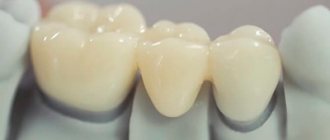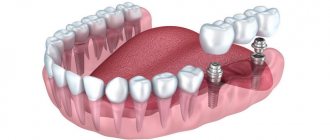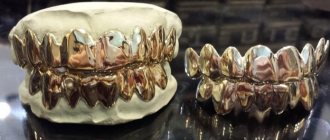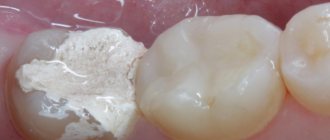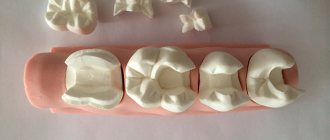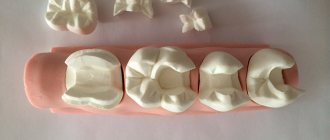Dental bridge - this is what people most often call dental bridges used by dentists to restore teeth when several units in a row are missing in a row. Dental bridges come in many different types, are made from different materials, and each type of structure has its own characteristics and advantages. Naturally, the price of different types of dental bridges will also differ.
In this article, we will tell you in detail about dental bridges: we will describe in detail the indications for their use, consider the types of dental bridges, the main characteristics, and also indicate approximate prices for production and installation in Moscow.
Indications for installation of dental bridges
Dental bridges are used to restore lost teeth, but not with single defects in the dentition, but when two, three or four teeth are missing. Bridges are applicable for the restoration of chewing and anterior dental units and effectively restore both the aesthetics of the dentition and all important functions of the teeth.
IMPORTANT: Installation of a dental bridge requires healthy supporting teeth. If the patient does not have strong teeth or has complete edentia (toothless jaw), the doctor may recommend either a removable denture or implantation followed by prosthetics with a conditionally removable orthopedic design. Implantation can be a good solution if the patient does not want to grind down healthy teeth for a bridge.
How to put a bridge on teeth -
Installing a bridge on teeth is carried out as follows... The teeth located on the sides of the missing one will act as support for the bridge. If only 1 tooth is missing, crowns are usually taken on one tooth on each side of the missing one. If 2 teeth are missing in a row, then a total of at least 3 teeth are taken under the bridge supports (one on one side of the dentition defect, and two on the other).
How to put a bridge on teeth: diagram and photo
Installing a bridge requires grinding down the supporting teeth for crowns, and here it must be taken into account that for different types of artificial crowns the thickness of the preparation will differ. For metal-ceramics, teeth are ground from the chewing surface by 2.0-2.5 mm, from the lateral surfaces by 1.5 mm (Fig. 4). For crowns made of metal-free ceramics - only 1.5 and 1.0 mm, respectively (Fig. 5). Moreover, the more tooth tissue is preserved under the artificial crown, the longer its service life will be.
Schemes for preparing teeth for crowns –
Moreover, please note that in the gingival zone, the tooth crown is ground in such a way that a so-called “ledge” (i.e., a step, Fig. 6) is formed along the entire perimeter of the tooth stump. The service life of the crown will largely depend on the quality of the ledge formation, because poor/inaccurate fit of the crown to the neck of the tooth in the area of the ledge - leads to the gradual entry of bacteria under the crown and the beginning of decay of the tooth tissue. And this happens very often.
Preparation of supporting teeth for prosthetics –
In many cases, teeth under artificial crowns are subject to depulpation, i.e. the nerve will need to be removed. This is due to the fact that deep in the tooth there is a neurovascular bundle (pulp), and the more tissue is ground off when preparing a tooth for a crown, the higher the risk of nerve injury. Accordingly, because Under metal-ceramics, more tooth tissue is ground off - here it is possible to leave mainly only large molars alive (they have a greater thickness of hard tissue around the nerve).
But for ceramic crowns, almost 2 times less tooth tissue is ground off, and in this case, almost all the teeth can be left alive. Keeping your teeth alive is very important because... after removal of the neurovascular bundle, the tooth stops receiving moisture and nutrition from the inside, which leads to an increase in the fragility of the hard tissues of the tooth and reduces its service life. The cost of removing nerves and filling root canals will depend on the number of root canals in the supporting teeth, and on average will be (for 1 tooth) –
- tooth with 1 root canal – from 2500 rubles,
- tooth with 2 channels – from 3800 rubles,
- tooth with 3 channels – from 5,000 rubles.
Dental bridge: before and after photos
Important: if the adjacent teeth from the missing one do not have fillings and are alive, then prosthetics with a bridge and grinding down the adjacent teeth for crowns is actually a very bad idea. The price of a dental bridge of 3 units made of ceramics or good metal-ceramics (taking into account the cost of preparing teeth for prosthetics) is almost always higher - when compared with the cost of installing 1 economy-class implant.
A dental bridge should be done only if the adjacent teeth from the missing one have large fillings (taking up more than 1/2 of the tooth crown in volume), and also if the nerves have been removed from them. Remember that the service life of the best crowns will be, at best, no more than 10-15 years, and what will happen to the supporting teeth after this time, and whether they can be re-used with prosthetics is still a big question. Your own living teeth (as opposed to artificial crowns) can last you much longer.
What a dental bridge looks like: description of design features
A dental bridge is a fixed prosthesis attached to supporting teeth and used to eliminate multiple edentia (the absence of several teeth in a row). The main elements of a dental bridge are artificial teeth and fasteners, with the help of which the prosthesis will be firmly fixed in the oral cavity.
Attachments for dental bridges can be in the form of:
Dental crowns placed on abutment teeth
Tabs
Clammers
Sometimes the design of a dental bridge also includes an additional element - a part designed to imitate a section of gum. Externally, the prosthesis resembles a bridge – that’s why it got its name.
The intermediate part of the dental bridge may have a different mechanism of connection with the soft tissues of the oral cavity:
- Flushing connection. In this case, a small space remains between the dental bridge and the soft tissues of the mouth, which ensures free passage of food under the denture, and therefore easier care for it;
- Tangent connection. With this type of connection, one side of the bridge will touch the gums, and such prostheses are especially relevant in the restoration of teeth included in the smile zone. They provide better aesthetics, are easy to use, and do not interfere with normal diction;
- Saddle-shaped. With this connection, the bridge connects to the soft tissues of the mouth as tightly as possible.
The type of dental bridge design is selected at the stage of planning prosthetics and together with the doctor leading the treatment!
Advantages and disadvantages
The benefits of dental bridges are numerous. It costs to install a bridge:
- To prevent jaw bone atrophy
- To prevent the displacement of adjacent teeth by closing the free space
- To prevent tooth decay and gum disease caused by food accumulation in areas where teeth are missing
- For immobilization of teeth in periodontopathies
- To restore the aesthetics and functionality of the dentition
However, the need to prepare healthy teeth adjacent to the defect is a major disadvantage of bridges, so for many patients, implants that do not require intervention on healthy teeth are a more practical solution. Implants are fixed in the bones of the upper or lower jaw and single crowns or bridges consisting of several crowns are installed on them.
Types of dental bridges
At the very beginning of the material, we mentioned that there are quite a large number of different types of dental bridges. The classification of bridges is carried out both according to the material of manufacture and the production technology.
Based on the first feature, the following types of dental bridges are distinguished:
Metal
Metal-ceramic
Ceramic
Zirconium
Plastic
Based on production technology, the following dental bridges are distinguished:
- Adhesive. It is most often used when only one tooth needs to be restored with a bridge. Such a prosthesis has a base - a fiberglass arch on which the artificial tooth is located;
- Stamped dental bridges are several dental crowns welded into a single structure;
- Cast dental bridges are the most durable denture option.
The material and manufacturing technology of a dental bridge will determine its cost and also its main performance characteristics, and below we will look at the main types of bridges, their features, pros and cons.
But first, let’s answer a question that patients often ask orthodontists – which is better, a dental bridge or implants?
What to do if a temporary bridge falls out
If the temporary bridge falls out, then there is nothing to worry about. After all, it is glued to temporary cement, which has weaker fixing properties. Therefore, you need to contact an orthopedist to glue the structure in place. Or, if a permanent prosthesis is already ready or the implants have taken root, then the temporary bridge will not be put back, but the permanent one will be fixed immediately.
Complex on 4 OSSTEM implants with delayed loading - from RUB 170,000.
Complex implantation Osstem (South Korea) with delayed loading after 4-6 months.
Guarantee for the doctor’s work - unlimited Call now or order a call
Opening hours: 24 hours a day - seven days a week
Which is better - a dental bridge or an implant?
Here we need to make an important note - prosthetics can be carried out without implants, but implantation necessarily involves the stage of prosthetics. Of course, implantation of implants will increase the final cost of treatment, however, when installing a prosthesis on implants, you will not have to grind down healthy teeth, in addition, the dental bridge will be fixed as firmly as possible in the oral cavity and this increases the comfort of its use, as well as the useful life of the prosthesis.
But of course, the patient and the doctor must decide how to restore teeth in a specific clinical case. For example, if examination and diagnostics reveal absolute contraindications to implantation, then lost teeth will have to be restored using classic prosthetics and the installation of a dental bridge on the supporting teeth.
When can you build a bridge?
It is important to correctly draw up a prosthetic plan and ensure the stability of the supporting teeth.
Movable units or those affected by caries cannot serve as the basis for the structure. An upper or lower bridge is installed on natural teeth. When asked by patients: “Is it possible to install a bridge structure on an implant on one side and a tooth on the other?” there can only be a negative answer. A real, living dental unit has some mobility, and the implant is fixed rigidly, motionless, as in the following photo:
The bridge will loosen the implanted artificial root and place an inadequate load on the natural tooth. Plus, the service life of the implant is long, often lifelong. Real units are more vulnerable. The supports can be either two real teeth or a pair of implants.
If a tooth has been removed, but the crowns and roots of the units located next to the gap are strong enough, then a bridge is one of the rational and inexpensive methods of prosthetics.
Metal dental bridges: pros, cons
Metal dental bridges can be called an outdated type of bridge prosthesis - they are almost never used in modern dental prosthetics, because the number of their disadvantages significantly outweighs the number of advantages. Dental bridges made of metals and their alloys are too heavy and bulky; their installation causes increased wear and tear on healthy teeth.
In addition, metal dental bridges are not highly aesthetic; when wearing them, a person may constantly feel an unpleasant and pronounced metallic taste in the mouth. The risk of an allergic reaction cannot be excluded. If we talk about the advantages of metal bridges, there are only two of them - maximum strength and low price. Of all types of metal dental bridges, solid dentures will have the highest reliability and durability.
Thanks to casting production technology, such dental bridges have a long service life and are able to flawlessly withstand constant and heavy loads. Dental bridges of this type are recommended for installation in patients with deformation of facial features caused by atrophy of the jaw bone tissue.
Metal dental bridges can be made from different metals and their alloys, including precious metals. Typically, the raw material for the production of metal dental bridges is cobalt-chrome alloy. But gold can also be used. Then the price of the prosthesis will increase, but neither its aesthetics nor the degree of comfort in use will improve. If prosthetics are carried out in the area of the front teeth, then dental bridges made of metal ceramics and ceramics can be a much more successful solution; if you need to restore chewing teeth, you can opt for the strongest bridges made of zirconium.
How much does a metal dental bridge cost? The answer to this question will depend on the technology of its production, as well as on the number of crowns in the structure, and the type of metal used to make the prosthesis. For example, if ordinary metal is used and a bridge is made for two dental units using casting technology, the cost of the prosthesis will range from 8 to 9 thousand rubles.
Types of metal-ceramic “bridges”
All bridges are based either on natural teeth or on artificial roots - implants. The former are considered classical type prostheses. Constructions installed on natural teeth are much cheaper than dentures on implants. In addition, the treatment process takes place more quickly: there is no need to wait for the completion of the osseointegration process, which takes up to six months. In all other respects, an implant-supported bridge has a clear advantage. This is a more reliable, durable and aesthetic design: implants prevent bone tissue atrophy, and installation of a prosthesis does not require grinding of teeth. Read more about the method in a separate article.
Plastic dental bridges
The main advantage of a plastic dental bridge is its low price. It seems attractive to many people who want to restore lost teeth. However, before making a choice in favor of a budget dental bridge made of plastic, it is worth considering its disadvantages. And there are quite a lot of them. Among the disadvantages of plastic bridges:
- Low aesthetics. Artificial teeth made of plastic do not have the same beautiful natural shine as natural human teeth;
- Fragility. Dental bridges made of plastic easily break and are damaged by stress, but they cannot be restored - the broken element will have to be replaced, which implies new costs for prosthetics;
- Risks of allergic reactions;
- Over time, a plastic bridge will lose its visual appeal, since the plastic can darken under the influence of various factors. In addition, plastic wears out quite quickly. On average, plastic dentures will have to be replaced every 3-5 years.
Due to the listed disadvantages of plastic bridges, it is better to initially plan more expensive prosthetics using dental bridges made of metal-ceramics, ceramics and zirconium.
Cost of fixed prosthetics
| Dental bridge | Price, rub.) | Additional Information |
| Metal-ceramic | 8850/11850/14850 | For three units |
| Zirconium | 40500 | For three units |
| Prettau ceramic bridges | 40500 | For three units |
Dentistry of Amazing Prices offers patients the most favorable conditions for prosthetic bridges in the absence of teeth in a row. Study the cost of dental bridges in the price list on the dentistry website, taking into account the selected material and the number of crowns in the prosthesis. We are confident that our prices and quality of dental service will please absolutely everyone!
Metal-ceramic dental bridges: optimal price-quality ratio
Metal-ceramic dentures are quite in demand among patients and this is not surprising, because they are not inferior in strength to metal dental bridges, but at the same time have a much more aesthetic appearance. A metal-ceramic bridge achieves high aesthetics due to the fact that its crowns are covered with a layer of ceramic mass. Layer-by-layer application of ceramics onto a metal base allows you to obtain artificial teeth with the same shade as healthy teeth.
IMPORTANT: Despite the good aesthetics, dentists do not recommend choosing metal-ceramic dental bridges for dental prosthetics in the smile area. The fact is that the metal base of such a prosthesis can be quite noticeably visible through the ceramics. To restore the front teeth, it is best to use metal-free dental bridges that have the most natural and aesthetic appearance.
A metal-ceramic dental bridge can be placed both on abutment teeth and on implants. The price of the bridge will depend on the manufacturing technology and the number of units being restored. The average cost of a metal-ceramic bridge for two dental units is 16,000 rubles.
Unfortunately, it is not always possible to place a metal-ceramic dental bridge on a patient. Bridges made from this material cannot be used if:
- Advanced periodontal diseases;
- For some malocclusion pathologies. If malocclusion is detected, orthodontic treatment is required before installing a metal-ceramic dental bridge;
- Low natural crown of teeth.
Contraindications to the installation of metal-ceramic bridges are identified at the first stage of prosthetics, during which the patient undergoes examination and diagnosis.
Bridge installation: contraindications and indications
Direct indications for the installation of bridges are the absence of one chewing tooth or from one to four front teeth with supporting teeth on either side of them that can withstand the increased load. Dental prosthetics using a bridge has a number of relative and absolute contraindications. These include:
- absence of no more than 4 incisors, 2 premolars, 1 molar in a row;
- bruxism (involuntary grinding of teeth, the harm from which can be mitigated by wearing special mouthguards);
- pathology of the bite (in this case, you will have to undergo orthodontic treatment before prosthetics);
- periodontitis and severe periodontal disease;
- pathological abrasion of hard dental tissues;
- diseases of the bone tissue of the jaw (for example, osteoporosis, osteomyelitis);
- acute inflammatory diseases of the oral cavity;
- poor oral hygiene.
This also includes general contraindications to surgical intervention as such: such as, for example, problems with blood clotting, allergies to painkillers, chronic diseases in the acute stage, taking anticoagulant medications, mental illness, and more.
Ceramic dental bridges
Ceramic dental bridges are the best choice if you need to restore the front teeth that fall into the smile area. Dental ceramics is a material that has transparency and light transmission similar to natural tooth enamel, so dentures made from it have the most natural appearance; they are very difficult to distinguish from natural teeth. However, in terms of strength, ceramic bridges will, of course, be inferior to prostheses made of metal and metal-ceramics. The price for a ceramic bridge of 2 units is from 20 thousand rubles.
If, as a result of prosthetics, you want to get both high strength and aesthetics from the prosthesis, then it is worth considering the option of installing a dental bridge made of zirconium dioxide. This material has been used in dentistry relatively recently, and few patients have heard of it. Dental bridges made from high-quality zirconium dioxide are as attractive as ceramic products, and as reliable as metal structures. Moreover, zirconium is such a durable material that it can be used to make a bridge up to 6 dental units long! Another advantage of zirconium dental bridges is their durability - such a prosthesis can serve you flawlessly for 15-20 years! A zirconium bridge will cost more than a ceramic one - about 30,000 rubles per structure to restore 2 teeth.
IMPORTANT: The price of bridges will be influenced by production technology. The most modern technology for manufacturing dental bridges is CAD/CAM, which involves computer modeling of the prosthesis and its subsequent production using special milling equipment. The technology makes it possible to do without human intervention and, therefore, to avoid inaccuracies and errors. The finished prosthesis has high anatomical accuracy, which increases both the comfort of its use and the useful life of the dental bridge.
Advantages and disadvantages
Advantages
- Metal-ceramic bridges are ideal for chewing teeth. The products are durable and in these places they serve regularly throughout their entire life;
- are quite aesthetic, matched to the tone of the row;
- affordable price (implant-based ones are more expensive);
- reliability;
- speed of installation;
- easy care;
- good service life - 7-10 years, with support for implants from 15 years.
Flaws
- The need for grinding of supporting teeth and depulping, the tooth becomes fragile, therefore, bearing a large load;
- It is not recommended to place it on the front teeth, because metal tends to show through ceramics, this spoils the aesthetics, and over time a blue stripe appears at the junction of the gum and the edge of the prosthesis (to prevent this, dentists make a ledge when turning and use metal-ceramics with shoulder mass);
- metal can cause allergies (noble metals are less common), oxidizes from contact with saliva;
- abrasion of adjacent teeth from contact with metal;
- There are options with a longer service life.
Adhesive dental bridges: what are they and when are they used?
Adhesive dental bridges can be attached to abutment teeth without first grinding them down. For this purpose, special beams, fiberglass tape or wing-shaped fasteners are used. Adhesive dental bridges are used exclusively for the restoration of anterior teeth, but they are not used to restore chewing units, because such prostheses do not have the required degree of strength.
The advantages of adhesive dental bridges include the following qualities:
- They allow you to carry out the restoration process as quickly as possible;
- They do not require depulping or preliminary grinding of healthy teeth;
- Such bridges have good aesthetics;
- An adhesive bridge does not require complex maintenance and can be easily restored if necessary;
- The price of prosthetics will be lower than when using bridges made of ceramics, metal-ceramics and zirconium.
However, adhesive dental bridges also have a significant number of disadvantages. In particular, it is worth knowing that they are not distinguished by either high strength or durability. On average, such a prosthesis will have to be changed every 3-4 years. In addition, with adhesive prosthetics, the artificial tooth is built up above the gum, which ultimately leads to atrophy of the jaw bone tissue in the area of the defect.
Concluding the review of the main types of dentures, let’s say that the choice of a specific type of denture should definitely be made together with your doctor. The specialist will take into account the particularities of the clinical case and contraindications and will be able to offer you those options for dental bridges that can solve your problem and suit you in terms of characteristics and price.
Stages of installing a bridge on implants
The process includes several stages - diagnostic, surgical and orthopedic
Diagnostics and planning
Computer diagnostics are carried out, the data is necessary to assess the quality of bone tissue, and is used for virtual planning of the operation. In case of extended defects and complete absence of teeth, a bite examination is performed on an articulator so that after prosthetics the correct closure of the jaws is maintained. The treatment plan is drawn up by the orthopedist - he is the one who coordinates the work of the implantologist, determines the positioning points and the number of implants, taking into account future loads.
Implantation
During the operation, a calculated number of implants are implanted into the jaw. When bone tissue atrophies, osteoplasty is performed - bone tissue augmentation. This is necessary to create reliable fixation of the implants. We work only with premium Nobel Biocare systems and use original prosthetics . For anxious patients with cardiac problems, the possibility of surgery in medicated sleep is provided.
Temporary prosthetics
It will not be possible to install a permanent prosthesis immediately after implantation - you cannot create a strong load so as not to disturb the position of the implants. But you will never leave our Center without an orthopedic solution. On the same day, we will manufacture and install a temporary bridge from lightweight materials, which will hide the defect and last 2-4 or 6 months while the implants take root.
Permanent prosthetics
Permanent bridges are made after fittings and prototyping, taking into account the bite. Installed using transocclusal (screw) fixation. Unlike cement fixation, which is practiced in some clinics, the bridge, if necessary, can be removed without damaging the abutments (the connecting link between the implant and the prosthesis).
How dental bridges are installed: a detailed overview of the main stages of prosthetics
Dental bridge prosthetics begins with examination and diagnosis. This is a very important stage, as it allows you to eliminate possible contraindications, as well as select the optimal type of dental bridge for a particular patient. At the first stage of treatment, the doctor will examine the oral cavity, you will also be referred to an X-ray of the jaw, and may also be prescribed some general tests. Based on the information collected, a treatment plan is drawn up.
The further process of installing a dental bridge will involve the following steps:
1. Preparation of the oral cavity for prosthetics. In order for the installed dental bridge to last for a long time, it is extremely important that the patient’s mouth is free of diseased teeth, inflamed gums, tartar and plaque. Therefore, before prosthetics, it is necessary to treat caries, as well as sanitation of the oral cavity, during which the teeth are thoroughly cleaned of hard and soft dental deposits.
2. Next, teeth are prepared for the installation of a dental bridge. They are subjected to grinding and sometimes depulping.
Depulpation - this term in dentistry refers to the procedure for removing the dental nerve. Why is it needed before installing a dental bridge? The fact is that when grinding some teeth, there is a possibility of overheating of the pulp, which can lead to the development of pulpitis in the future. Therefore, sometimes a decision is made to pre-depulpate teeth before prosthetics with a dental bridge or crown.
3. The doctor takes impressions of the ground teeth, which are sent to the laboratory and where, based on them, first a computer model of the dental bridge is made, and then the prosthesis itself. When the prosthesis is ready, the patient is invited to try it on.
4. If during the fitting of the dental bridge no inaccuracies in its manufacture are revealed, the patient is satisfied with the prosthesis - it is fixed in the oral cavity using special dental cement. After installing a dental bridge, the dentist gives the patient detailed advice on caring for the oral cavity and dentures.
Stages of installation and manufacture of a bridge prosthesis
Probably every patient preparing for bridge prosthetics is interested in the question: how to install a dental bridge and how long does it take? Installing a dental bridge involves several stages. First of all, the doctor assesses the general condition of the patient’s oral cavity, performs sanitation and determines whether the supporting teeth are able to withstand the increased chewing load. The most important point in installing a bridge is the preparation of the supporting teeth. They need to be depulped and the canals carefully sealed, then ground for installation of a crown. All this is called preparation for bridges. If the teeth on the sides of the missing ones are badly damaged, they are strengthened with inlays. It is worth noting that the latest developments in modern dentistry make it possible in some cases to avoid depulpation, that is, removal of nerves. There are situations when the supporting teeth are completely healthy and making them “dead” by removing the nerve is not so advisable. After preparing the supporting teeth, their color is determined and impressions are taken from both jaws of the patient, which are transferred to the dental laboratory, and the bridge itself is made there - abutment crowns, the inside of which follows the shape of the ground teeth, and the intermediate part of the bridge, which is an artificial tooth or teeth with anatomically shaped fissures.
The manufacturing stage of a bridge can take from 1 to 3 weeks. During this period, a temporary bridge can be installed in order to protect the supporting teeth from various irritants or restore aesthetics in the smile area. At the next stage of prosthetics, fitting, fitting and fixation of bridges are carried out. They should fit tightly on the teeth, not interfere with the closure of the remaining teeth and not differ from them in color. In order to install a dental bridge, a specialist needs a special cement that securely fastens the supporting teeth and the crowns covering them. If, a few days after installation, any problems arise or discomfort appears, you should contact an orthopedic dentist as soon as possible.
Can complications occur after installing a dental bridge?
Complications after installing a dental bridge are possible and they can arise both due to the doctor’s mistakes and the patient’s fault, for example, due to failure to follow the recommendations of a specialist in caring for the oral cavity and prosthesis. The most common types of complications are:
1. Inflammation of periodontal tissues after the installation of a bridge. The inflammatory process may occur due to the fact that the bridge design was chosen incorrectly or the patient insisted on installing exactly this type of prosthesis. To avoid such a complication, you should listen to the opinion of a specialist when choosing a dental bridge for prosthetics!
2. Pain when chewing food. This phenomenon after the installation of a dental bridge occurs due to errors in the production of the prosthesis. If you notice discomfort when eating, and it does not go away within a few days, contact the clinic immediately. Inaccuracies in the manufacture of the prosthesis need to be corrected not only because such a bridge is inconvenient to use, but they can lead to rapid destruction of the supporting teeth.
3. Pain in the teeth under the crowns of the installed bridge. This complication can manifest itself due to poor oral hygiene and poor quality of the prosthesis. If the bridge was made with inaccuracies, the crowns will not fit tightly to the supporting teeth, which means that pathogenic microorganisms can easily get into them, which will cause caries and pain in the teeth. In this case, you definitely need to visit the dentist so that the doctor removes the denture and treats caries.
4. Development of pulpitis. This complication occurs when the supporting teeth are improperly prepared for the installation of a dental bridge. If, when grinding a tooth, the doctor allows its tissues and pulp to overheat, an inflammatory process may develop in the future.
These are not all the types of complications that can manifest themselves after installing a dental bridge if you do not follow the recommendations of your doctor or undergo treatment in a bad clinic that does not seek to treat patients, but to make money from them. Therefore, always carefully choose dentistry for your treatment!
Is it possible to glue the bridge in place yourself?
What to do and how to secure a dental bridge if it falls out at home? Let us immediately point out that putting a fallen bridge back on your own is not the best idea. Since this can injure the supporting and neighboring teeth, harm the gums (if you suddenly decide to glue the bridge with pharmaceutical cement or household glue). The consequences can be unpredictable - up to the removal of “damaged” teeth or implants. Therefore, it is better to entrust your teeth to a professional dentist.
What to do if the installed dental bridge begins to wobble?
If you suddenly feel that the dental bridge installed for you has begun to wobble, contact the dentist immediately! There are several reasons why this phenomenon may occur:
1. One or two supporting teeth are broken.
2. The composition used for the final fixation of the dental bridge in the oral cavity has deteriorated.
You cannot determine the reason why the dental bridge suddenly began to wobble on your own; you need professional diagnostics. When you come to the clinic, the doctor will conduct an examination and also prescribe an X-ray that will allow you to assess the condition of the supporting teeth and their roots and find out exactly why the dental bridge no longer holds firmly in the oral cavity.
In any case, to secure the dental bridge, it will have to be removed. There are no other ways to secure the structure in the oral cavity, and we strongly recommend that you do not follow advice from the Internet on securing dentures with glue and other compounds. This can lead to the most negative consequences - the development of a severe allergic reaction, inflammation and burns of the soft tissues of the oral cavity.
What will the doctor do?
If the dental bridge is loose but not damaged, the dentist:
- Remove the prosthesis;
- If necessary, perform dental treatment;
- Reinstall the structure, securing it with fresh cement.
If the denture breaks, the dentist will install a new one.
To make the right decision, you need to know the exact reason. To do this you will need:
- Carry out a detailed inspection;
- Find out how long the structure will be used;
- What sensations does the patient experience?
- Take an x-ray of the supporting teeth.
What to do if a dental bridge falls out?
There can be only one answer to this question - contact the dentist as soon as possible! A dental bridge may fall out due to the destruction of supporting teeth, due to the fact that its service life has expired.
You should not forget about the service life of a dental bridge; each type of denture has its own useful life, after which it is recommended to replace it with a new product. If you promptly monitor the condition of your dental bridge, as well as regularly undergo dental examinations and professional oral hygiene, you are guaranteed not to encounter the problem of the prosthesis falling out.
Care
Dentures for 1 tooth require careful regular care. One of the most common reasons for premature denture replacement and oral problems is insufficient or careless hygiene. Brushing with a brush and paste should be done morning and evening and after every meal.
It is also recommended to rinse your mouth regularly, preferably with an irrigator, which helps flush out tiny stuck food particles. You should see your dentist for a professional cleaning twice a year.
Free consultation on the cost of treatment in our dentistry
Leave a request and the clinic administrator will contact you within 15 minutes!
If such a nuisance does happen and your dental bridge falls out, do not delay your visit to the doctor. Grinded teeth are extremely vulnerable to the action of bacteria and an inflammatory process may occur, which will force the removal of diseased dental units. And whether it will be possible to build a bridge then is unknown. Because bridges require supporting teeth or must be placed on implants!
You should also urgently contact a dental clinic if the tooth under the bridge hurts or swelling appears on the gum above the installed denture. Self-medication will not help here, because all these signs indicate an inflammatory process in the supporting teeth, the development of which can only be stopped by professional treatment.
Contraindications
There are cases when a bridge made of metal-ceramic crowns should not be installed.
Relative
the procedure can be carried out with extreme caution
- gum disease;
- untreated caries, pulpitis on supporting teeth;
- bite pathologies.
Absolute
the procedure is strictly prohibited
- metal allergy;
- bruxism;
- psychological diseases;
- children under 18 years of age.
How a dentist can help
When answering the question of what to do if a dental bridge is loose, it is worth emphasizing again that first of all you need to seek professional help. In such cases, the orthopedic structure is removed, for which in modern dentistry they usually use ultrasonic units for decementing. Also for this purpose, special crown and bridge removers can be used, for example, a Kopp apparatus or other equipment. In some situations, if the prosthesis is intact and there are no signs of damage on it, it can be installed back after troubleshooting.
Kopp apparatus for removing orthopedic structures
If the orthopedic structure cannot be removed without damage, the specialist may resort to the help of special scissors and crown-cutting forceps. In this case, after that you will have to take impressions again and create a new prosthetic device.
After removing the bridge, the doctor carefully examines the condition of the mucous membrane and supporting teeth. If necessary, anti-inflammatory therapy is prescribed, but first the specialist removes plaque and accumulated deposits. In most cases, it is necessary to re-fill the channels in the supports, install new pins or stump inlays. If the teeth have already decayed too much, they are removed and after restoration they return to the question of finding alternative methods of restoration, for example, the optimal solution in such a situation would be implantation.
It also happens that the reason for bridge mobility is the end of its service life. If cracks, severe abrasions or chips appear on it, a new structure will need to be made.
Reasons to contact RUTT
Only contacting a licensed clinic with experienced doctors will help avoid misunderstandings and unnecessary headaches. Only highly qualified doctors work in our RUTT center. The latest equipment, high-quality materials, its own laboratory and research base with high-precision devices. All this guarantees a predictable, excellent result.
We install not only metal-ceramic bridges on teeth, but also perform implantation, including one-stage implantation. Come for a free consultation and the doctor will select the type of prosthetics that is ideal for you. This will include taking into account all your wishes and the estimated budget for dental services.
You can learn more about the cost of prosthetics with a metal-ceramic bridge on our website in the “Prices” section or by calling.

